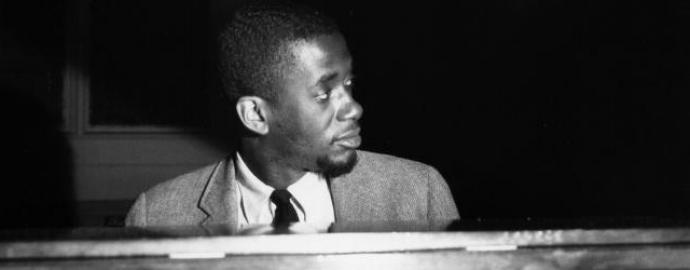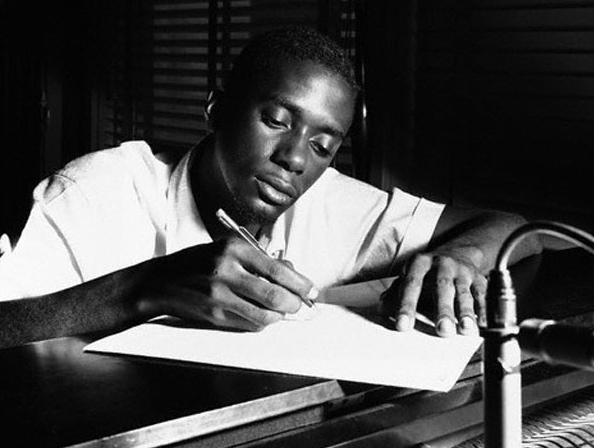
Robert Henry “Bobby” Timmons (pianist) was born on December 19, 1935 in Philadelphia and passed away on March 1, 1974 in New York City.
Robert Henry Timmons was born in Philadelphia in 1935, raised by his grandfather who was a minister in a church. The young Timmons began formal piano lessons at age six, and was the organist at his grandfathers’ church. This early formative period would certainly be a factor in his piano approach. He was be able to innovate and improvise on his gospel foundations and brought them into jazz. He had the lyricism of a Bud Powell in his solos, (who didn’t in the 50’s) combined with a very dominant left hand which was reminiscent of the stride and boogie players, but it was his sense of that down home chording and timing that really identified him.
Timmons moved to New York City in 1954 and made almost an immediate impact on the jazz scene. Alongside Wynton Kelly, Timmons became one of his generation’s most in-demand pianists. His first major professional experience was with trumpeter, Kenny Dorham, which is captured on the 1956 Blue Note release Round About Midnight At the Cafe Bohemia. This LP featured Sam Jones on bass and Kenny Burrell on guitar. Burrell played with Dorham for a little over two months, leaving in April of 1956.
The young pianist’s next major gig was with trumpeter and singer Chet Baker. Timmons joined Baker’s group in the summer of 1956, and their relationship is documented in recordings from the group’s performance at the Forum Theatre in Los Angeles from July of that year. One of these songs To Mickey’s Memory, featured good solos by both Baker and Phil Urso on tenor. Timmons played with Baker for the rest of the year, having appeared on the recording Chet Baker Big Band, which also featured Urso on tenor saxophone, Art Farmer on alto saxophone, and James Bond on bass.
In 1957, Timmons started playing with saxophonist Hank Mobley. He appeared on the album Hank, which also featured Donald Byrd on trumpet and Philly Joe Jones on drums. He also appeared on saxophonist Sonny Stitt’s album for Verve, Personal Appearance and trombonist Curtis Fuller’s Blue Note release The Opener. That same year Timmons appeared on another release this one by trumpeter Lee Morgan. The album The Cooker featured Timmons along with bassist Paul Chambers and drummer Philly Joe Jones on the song Lover Man.

In late 1957, Timmons continued his accelerated musical pursuits as he started playing with Maynard Ferguson. He started with the trumpeter in August of 1957 and appeared on the Mercury recording Boys With Lots of Brass. By 1958, the 23-year-old pianist was still adding to his resume. This time he joined forces with drummer Art Blakey’s Jazz Messengers. With Blakey, Timmons exhibited his funky, gospel tinge in a group that also included Lee Morgan on trumpet and Benny Golson on tenor saxophone.
The group released Moanin in 1958, with the title track being one of Timmons most enduring and career-defining compositions. The tracks from this album were widely influential, including the songs Blues March, written by Benny Golson, and The Drum Thunder Suite, which featured Blakey in his quintessential role as the time setter and groove keeper for the band.
Also in 1958, Timmons recorded with guitarist Kenny Burrell for his album Blue Lights and also appeared on Pepper Adams Riverside release 10 To 4 at the 5 Spot. The Jazz Messengers also released the album Drums Around the Corner, which featured Roy Haynes on drums, Philly Joe Jones on drums, and Ray Barretto on congas along with the working rhythm section of Timmons, Blakey, and Jymie Merritt on bass. By 1959, Timmons had become one of the most reliable sidemen in jazz and played in both the Jazz Messengers and in alto saxophonist Cannonball Adderley’s band.
On the 1959 Fantasy release The Cannonball Adderley Quintet In San Francisco, Timmons song “Dis Here“, became a minor hit. This waltz featured Adderley on alto, Nat Adderley on cornet/trumpet, Louis Hayes on drums, and Sam Jones on bass. That same year, Timmons appeared on several Jazz Messengers releases. These albums included Les Liaisons Dangereuses and At the Jazz Corner of the World, which documented the Jazz Messengers April 15th, 1959, set at the Birdland jazz club. As if this weren’t enough for the twenty-four year old pianist, he managed to find time to appear on Art Farmer’s release Brass Shout and Kenny Burrell’s album On View At the 5 Spot.
In 1960, Timmons released his first album as leader called This Here Is Bobby Timmons, released on Riverside. It featured Timmons along with Sam Jones on bass and Jimmy Cobb on drums. By this time, Timmons was still playing with the Jazz Messengers and appeared on their 1960 release A Night In Tunisia. This album was one of the first to feature newcomer Wayne Shorter on tenor saxophone as he can be heard on the song So Tired.
Timmons workload in 1960 was more than the previous year as he appeared on another Adderley album Them Dirty Blues and on tenor saxophonist Arnett Cobb’s release Movin Right Along for Riverside. Also in 1960 Timmons appeared on albums by bassist Sam Jones, trumpeters Lee Morgan and Dizzy Reece and released his second album as a leader Soul Time. Soul Time featured Blue Mitchell on trumpet, Art Blakey on drums, and Sam Jones on bass. In 1961, Riverside released Timmons third album as a leader entitled Easy Does It, which featured his working bassist Sam Jones and frequent collaborator Jimmy Cobb on drums.
Timmons continued his association with the Jazz Messengers through June of 1961. He appeared on the Art Blakey album The Witch Doctor along with staple Jazz Messenger members Lee Morgan and Wayne Shorter. That same year, Riverside released a live trio record The Bobby Timmons Trio In Person, which documented their October 1, 1961 performance at the Village Vanguard. This album featured the song “Dat Dere.”
 Unfortunately, by the early 1960s Timmons’ career was sliding. he had developed a severe addiction to alcohol, which ultimately claimed his life.
Unfortunately, by the early 1960s Timmons’ career was sliding. he had developed a severe addiction to alcohol, which ultimately claimed his life.
Despite problems in his personal life, Timmons still managed to appear on Free by Benny Golson, which featured Timmons on the Rodgers and Hart song My Romance. Timmons released several other albums as a leader including 1962’s Sweet And Soulful, 1963’s Born To Be Blue, and 1964’s From the Bottom, which featured Timmons on piano, organ, and vibraphone.
Compared with his earlier musical output, Timmons had definitely declined by the late 1960s having appeared on only an album by tenor saxophonist Dexter Gordon in 1969 and releasing one of his last albums as a leader that same year. Timmons died on March 1st, 1974 in New York City from liver complications that were brought on by his alcohol dependency. Timmons was married at the time of his death.
In twelve short years, Timmons created a musical catalogue which rivals that of some of the most influential and prolific artists in jazz. The influence of his signature blend of hard bop can still be heard in the fingers of many pianists today.
